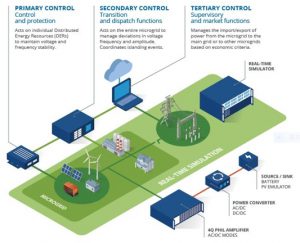
OPAL-RT TECHNOLOGIES has recognized the power of HIL and PHIL. As with other electrical systems, field testing of microgrid products and integrated systems on live grids can be risky. For these reasons, many microgrid applications are well suited to Hardware-in-the-Loop (HIL) and Power Hardware-in-the-Loop (PHIL) testing. The project’s mission is mainly to help engineers employ these types of Real-Time Simulation for their microgrid projects. As for the HIL Testing, the structure is divided into three parts: “primary control” to maintain frequency stability, “secondary control” to manage deviations in voltage frequency and amplitude, and “tertiary control” to manage the import/export of power from microgrids to the main grid or to the other microgrids. For the PHIL testing, it is to emulate AC or DC grids to test power devices (inverters, rectifiers, batteries, etc.) under realistic conditions while incorporating closed-loop interactions with a real-time simulator. It requires a power amplifier or power supply based on specific application. In addition, in order to model the microgrid simulation project in one tool, this project also develops the power system simulator, HYPERSIM, running accelerated simulations for in depth EMT analysis on their personal computer and going to real-time for large-scale Hardware-in-the-Loop (HIL) testing.